Table of Contents
ToggleIntroduction
So here we have the Shuttle Spacewalker AK32A, which is an evolution of the AK32 I already reviewed here. The only difference is the updated chipset, which is now the VIA KT266A, as opposed to the KT266, that is used on the Shuttle AK32.
The thing that is really special about this board is, that either SDR or DDR memory can be equipped. While this is (was) a common thing among KT266 based motherboards, there are only very few KT266A based boards that give you this option - almost all of them only offer DDR memory slots. A KT266A based system with SDR memory should the the fastest possible platform with this type of memory (if someone happens to be after building something like that).
I am also very curious how much faster the KT266A runs with SDR memory compared to the vanilla KT266. It is common knowledge, that VIA's KT266 was largely unstable with a command rate of 1T, whereas the successor usually runs perfectly at this setting. This alone should give a rather huge boost in performance - with DDR memory.
The command rate setting was a new feature for DDR memory and is not available when using SDR memory. So I am excited to see, if the greatly improved memory performance, that the KT266A is said to have compared to its predeccessor, is only thanks to the now stable 1T command rate, or if there's more to it.
Gallery
Specifications and Features
Chipset:
- VIA KT266A (VT8366A) Northbridge
- VIA VT8233 Southbridge
CPU Support (with latest BIOS):
- Athlon Thunderbird (ALL)
- Athlon XP Palomino (ALL)
- Athlon XP Thoroughbred (all FSB266 models up to 2600+)
- Athlon XP Thorton (all FSB266 models up to 2400+)
- Duron Spitfire (ALL)
- Duron Morgan (ALL)
- Duron Applebred (ALL)
Memory Support:
- 2 SDR DIMM slots
- 2 DDR DIMM slots
- Maximum total memory 2 GB
- no simultaneous usage of SDR and DDR memory
Expansion Slots:
- 1x AGP slot (1,5 / 3,3V) up to 4x
- 5x PCI slots
Connectors (internal):
- 2x IDE (UDMA100)
- 1x Floppy
- 4x USB 1.1
- 3x 3-pin fan connectors total (1x CPU, 2x chassis)
Connectors (external):
- 2x PS/2
- 2x COM/RS-232
- 1x Parallel Port
- 2x USB 1.1
- 3x 3,5" Audio Jacks (Line-Out, Line-In, Mic)
- Gameport
You might have noticed, that I didn't mention the audio chipset specifically, as I think far better solutions than the old onboard chipsets are readily available for little money. Very commonly recommended are the Creative Soundblaster Live! cards for example, which offer fantastic compatibility with our beloved old games and sound far better than any onboard solution of that era.
I also don't list (from a retro-gamers perspective) useless connectors and features like IR, Smartcard- or Wake-on-LAN connectors and so on.
Overclocking Features:
- Adjustable Multiplier (BIOS) from x5 to x14
- Adjustable FSB (BIOS) from 100 to 166 MHz in 1 MHz steps
- Adjustable VCore (BIOS) from +- 0,100 V in 0,025 V steps
The AK32A can be set up completely jumperless. If a new CPU is installed, the motherboard boots with FSB100, which can then be adjusted in 1 MHz steps from within the BIOS.
Documentation, Downloads, Drivers
Shuttle still hosts the original support pages from “back in the day” for their legacy products, which can be found here:
From there, you can select the “until 09/2004” link, to get to the oldest available iteration of shuttle's support portal. I must admit that it delivers the proper “retro feeling”, which is definitely a cool thing. All necessary downloads like the latest BIOS versions, as well as required flash tools, the manual and (outdated) drivers can be found there. CPU support lists, product specifications and a little FAQ section are also available there.
A download section for older BIOS versions for various legacy models can be found here:
https://download.shuttle.eu/Archive_2004/BIOS/
Another useful part of the support section is information on the different AK32 versions that were released. The following versions exist:
- AK32 “vanilla” V1.x
- AK32 V2.x aka AK322 aka AK32L
- AK32A
- AK32E
- AK32V
- AK32VN
While the AK32V(N) uses a smaller PCB, the other models use a very similar layout. The AK32 V2.x and the AK32A even look completely identical apart from some stickers and printings on the PCB. Shuttle helps you identify these with the following list (taken from the support site):
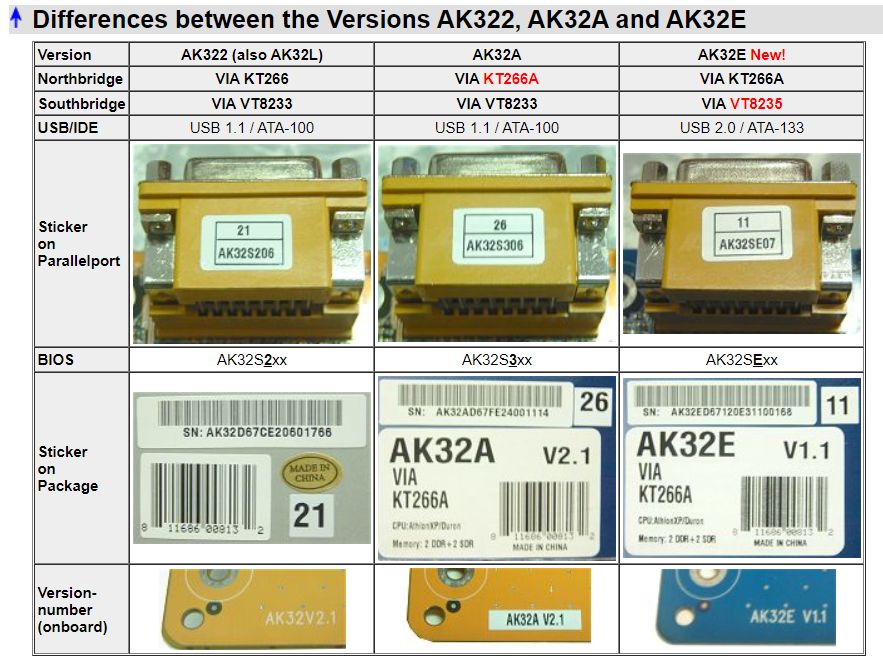
On the german support page is also a helpful table with an overview, that is missing in the english version:
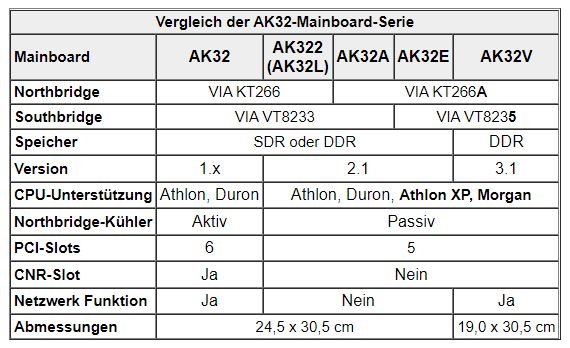
Design & Layout
=== This part is completely identical to the review of the AK32, since their layouts are also completely identical. Only the chipset differs. If you already read this one, you can skip this section. ===
The PCB Layout itself is pretty decent with some minor shortcomings. The best part of the layout is the lower right corner. Here we have the frontpanel connectors, the CMOS battery socket and the “Clear CMOS” jumper, a fan connector and the IDE- and floppy connectors, which sit nice and close to the edge of the PCB, together in one spot. Almost regardless of which expansion carts are installed, you will have all of these important things accessible even if the whole system is already completely assembled. Even the BIOS chip sits there, in case you need access to it.
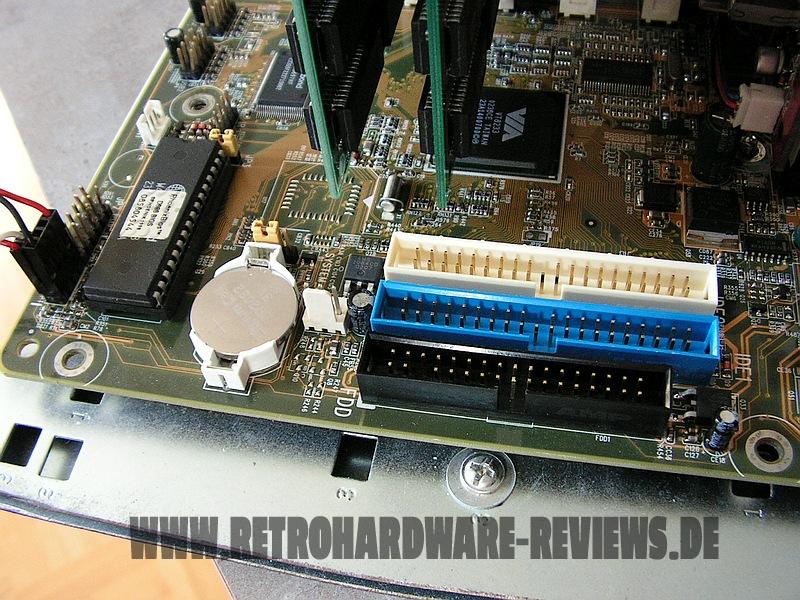
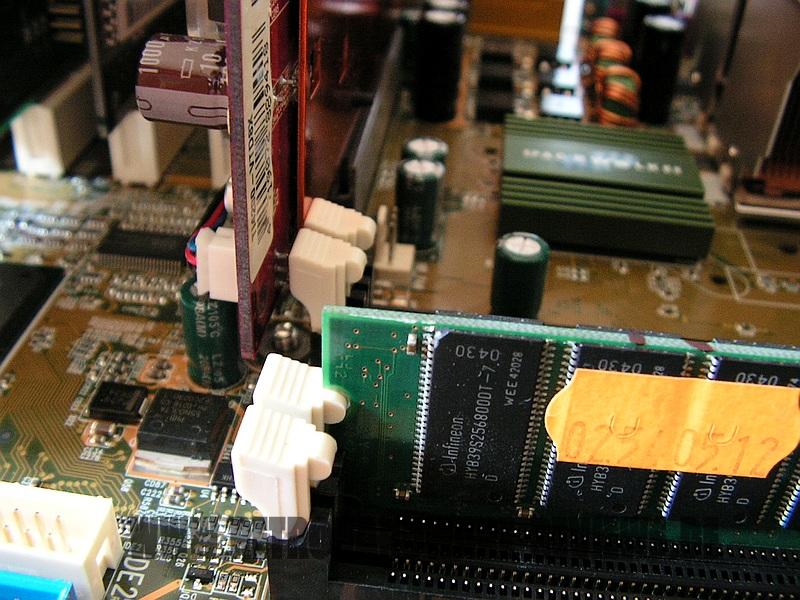
The memory slots sit tightly above the AGP port (which is also the case on many other boards), so that at least the DDR memory sticks cannot be removed or installed when your videocard is already in the system. If a long graphics card like the Voodoo 5 is installed, the SD-RAM slots are also blocked. With a Geforce 4 Ti 4200, they are accessible freely, but a Ti 4400 or 4600 would already be too long, as well.
The CPU socket is placed a fair bit lower than on many other boards, which should in theory reduce problems with larger CPU coolers. The space around the socket is also quite generous - apart from two nasty tall capacitors that are placed above the socket. These at least make the installation of the Alpha 8045 impossible - coolers with a smaller footprint on the bottom install without problems, however.
I tested the following eight CPU coolers regarding compatibility:
- Thermaltake Silent Boost K7
- Cooler Master HHC-001
- Swiftech MCX 370
- Alpha PAL 6035
- Alpha PAL 8045
- Smartcooler 60mm
- Arctic Cooling Copper Lite
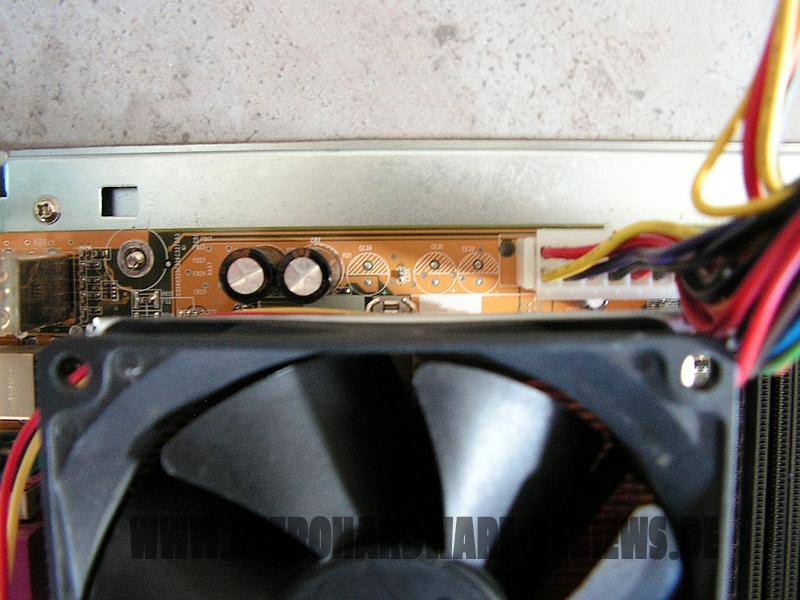
The Alpha 8045, as mentioned, does not fit, all others install fine. Even the lever of the Cooler Master HHC-001 does only reach a tiny bit over the PCB (even less than the picture suggests).
The ATX power cable connector is placed well on the upper edge of the board, which ensures that the power cable can be kept away from areas that need good airflow. Another plus is the inclusion of two 3-pin casefan connectors, which are located in good spots for connecting a front- and a rear fan.
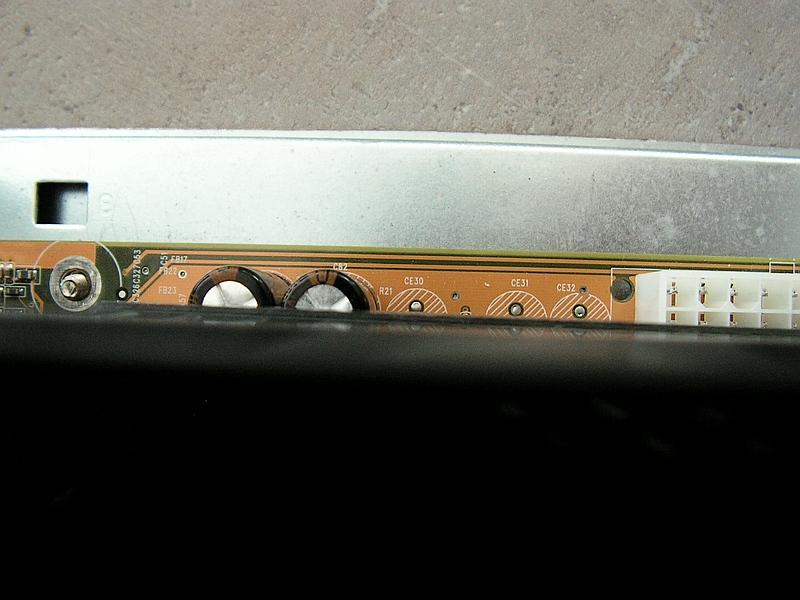
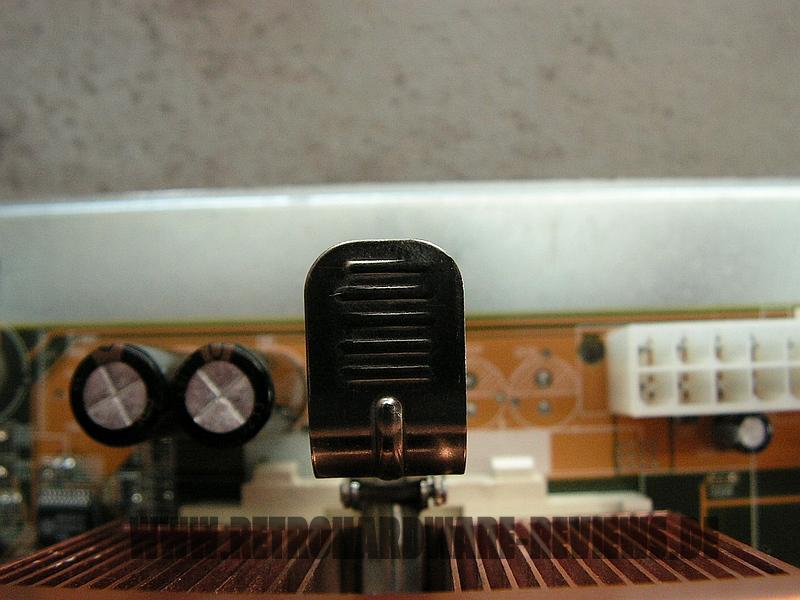
The thing I don't understand however, is the exclusion of another PCI slot. The space beneath the fifth PCI slot is completely unused (apart from some imprints). So either all expansion slots could have been moved further down to “unblock” the memory slots with a videocard installed, or a sixth PCI slot could have been included (as was the case with the AK32 v1.x by the way).
Test-System and Parts
Baseline Setup:
- CPU: AMD Athlon Thunderbird 1200C (FSB133)
Because I want to compare 1st Gen Socket A mainboards to their DDR follow-ups I have to use a CPU, which is available in FSB100 and FSB133 versions with the same clockspeed. Since I sadly don't have a Thunderbird 1400 B at my disposal, I will use the Thunderbird 1200 for my reviews and comparisons of these boards, which I have in the “B” (FSB100) and “C” (FSB133) version.
- RAM (DDR): 1x Corsair CMX512-3200C2 (XMS3202v4.2) = 512MB PC400 CL2
This Corsair XMS stick should allow the tightest timings at 266 MHz DDR and its size of 512MB is the perfect choice for Windows 98SE.
- RAM (SDR): 1x “Infineon 3rd” 512 MB PC133 SD-RAM
This memory stick has Qimonda chips rated at 7ns (=143 MHz). It runs flawlessly with the tightest timings at 133 MHz and its size of 512MB is the perfect choice for Windows 98SE.
- VGA: MSI Geforce 4 TI4200-VTD8X
To remove any GPU bottleneck for testing, I chose a Geforce 4 Ti as the primary graphics card for my test setups. The Geforce 4 Ti series are also known to pull a lot of power from the AGP port, so that possible problems in that department can also be revealed. It is also somewhat period correct and a good match for a high performance retro-machine that should be able to run late Windows 98SE games without any issues.
- VGA2: 3dfx Voodoo 5 5500 AGP
Many people consider the Voodoo 5 5500 the perfect card for (Win9x-) retro gaming. The Voodoo 5 benefits from a beefy setup, so a powerful Athlon Thunderbird or early Athlon XP is the perfect match for this card.
- Audio: Creative Soundblaster Live! (SB0060)
Creative's Soundblaster Live! can be found in many retro-machines. It offers great sound, perfect Win98SE compatibility and is still widely available for reasonable money. It was also known to cause problems with VIA-based 686B southbridges using old BIOS revisions and VIA chipset drivers. All this should be history at this point, but double checking on pontentially affected mainboards is still not a bad thing to do.
- LAN: 3Com Etherlink XL PCI
Just a good, reliable choice for networking. All legacy Windows versions all the way up from Win95 have built-in drivers for it, which is also a huge “plus”.
- HDD: Western Digital WD200BB (20GB 7200RPM)
No special intention behind this drive, it is just “there” and still works fine.
Additional Hardware for certain Tests:
- Silicon Image Sil3512 SATA Controller & Samsung PM871 128GB SSD
These two will help me measure the PCI bandwidth.
- Western Digital WD5000AAKB (500GB 7200RPM)
This drive will tell us, how big we can go with the onboard IDE connectors and how the performance is like.
- 2x Voodoo 2 12MB (SLI)
A pair of Voodoo 2s is a must have for any retro-machine, that doesn't feature a 3dfx card as the primary VGA solution. They offer compatibility to older Glide games and can be used with any more powerful primary graphics card. It is an important thing to know, how well these perform and if there are differences between all the available Socket A chipsets of that era or even between boards using the same chipset.
Drivers used:
- Chipset: VIA Hyperion 4in1 4.56v
- Geforce 4: nVidia Forceware 43.45
- Voodoo 5: Amigamerlin 2.9
- Voodoo 2: FastVoodoo 4.6
- SB Live!: Some driver from my archive, not shure 😉
- 3Com NIC: Windows 98SE preloaded driver
- SATA Controller: Some driver from my archive, not shure 😉
System Setup and Usage
Since I already reviewed the Shuttle AK32, which is the same board apart from the chipset, I was curious if the (in my opinion suboptimal) sharing between PCI slots and onboard devices does differ or not. After a quick test, I discovered that Shuttle didn't change anything in this department, so it looks like this:
- PCI #1: shared with PCI #5, no sharing with onboard devices
- PCI #2: shared with onboard Audio
- PCI #3: shared with USB
- PCI #4: shared with AGP port
Because of that, I initially left the SATA controller out of the system (like on the AK32) and started with this configuration:
- PCI #1: free
- PCI #2: SB Live!
- PCI #3: Voodoo 2
- PCI #4: Voodoo 2
- PCI #5: 3Com NIC
The BIOS is also identical to its predecessor, we don't get more options regarding memory timings or anything like that. With Cycle Length, Bank Interleaving and Command Rate (when using DDR memory) being the only options, you have very little control over your memory timings. With Cycle Length set to “2”, the timings using DDR memory were set to CL2 2-2-6, like on the AK32. Unlike the AK32, the 1T Command Rate setting was stable and all the benchmarks could be completed without issues.
When I swapped the memory stick for my usual 512 MB “Infineon 3rd” SDR stick, I got a POST right away. On the AK32, I had to reset the BIOS since it wouldn't post with the new memory stick. Moreover, this particular stick was detected with a wrong size in the older board, but the AK32A detected it fine and I ran the complete suite of benches with it.
Another difference to the older AK32 (and this time it is no improvement), is, that the memory timings using SDR memory are configured considerably slower then on the older model. On the AK32, the timings were set to CL2 2-2-6 when CL2 was configured in the BIOS (identical to the DDR memory timings). The AK32A however sets the timings to CL2 3-3-6. I also tested this with my second 512MB SDR stick, as well as with two 256MB sticks - the auto-configured (except for CAS latency) timings were always the same.
This is really sad, because now I cannot compare both boards using the same memory timings. I really don't understand why this change was made, because the older model already worked fine using the faster memory timings. And if CL2 does not work, one has always the option to either use CL3 or the “by SPD” setting. So why slow down the other timings in the “CL2” setting?
At least the system proved to be stable and the testing went as trouble-free as experienced with DDR memory before.
Benchmarks
Synthetic Measurements
Before we get into the 3DMark and gaming benchmarks, let's have a look at some theoretical numbers. These synthetic tests will exhibit the differences between the several chipsets and boards better than any game benchmark and provide us with "background information" that might be of use in understanding the timedemo results later.
Memory Performance: AIDA64 Cache & Memory Benchmark
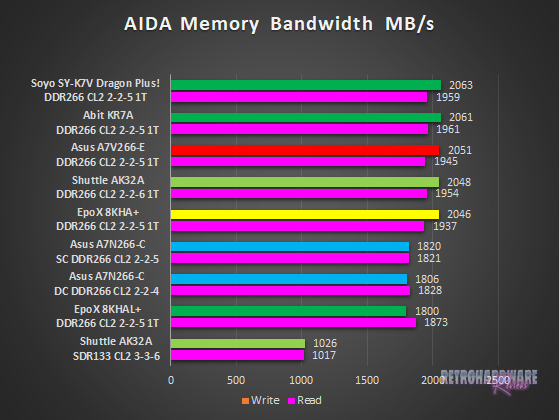
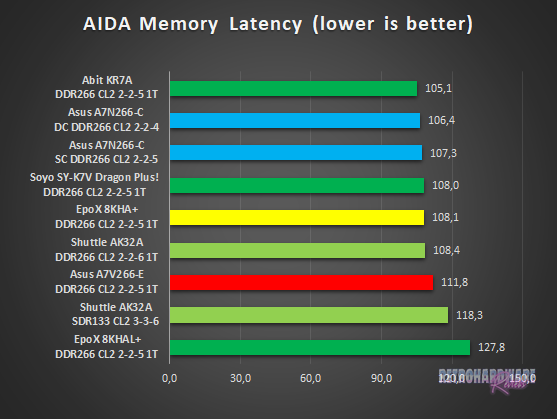
With DDR memory installed, the Shuttle AK32A performs quite good with a higher read speed and only a slightly lower write speed than the A7V266-E, despite the latter having a minor advantage in CPU clock speed of around 7 MHz. It even beats the Asus board in the memory latency test by a small margin.
Latency naturally increases with SDR memory installed, but is still quite a bit better than the memory latency measured on the EpoX 8KHAL+, which uses DDR memory. As expected, the memory bandwidth almost halves with the older memory, which puts the AK32A with SDR memory in last place in this test.
Application Performance: 7-Zip
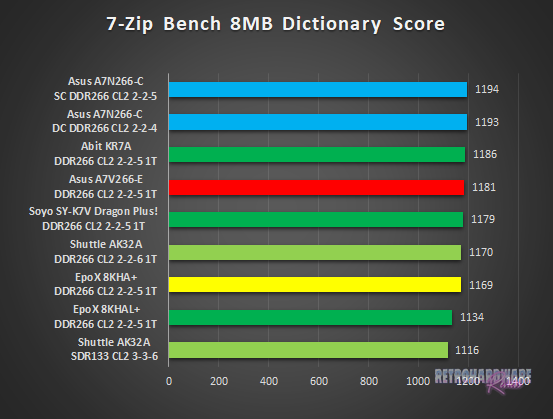
While most of the results in this test lie relatively close together, the AK32A is located rather in the lower half of the table. Its result with SD-RAM is obviously the lowest, but interestingly not significantly worse than that of the EpoX 8KHAL+.
AGP Performance: Final Reality Benchmark
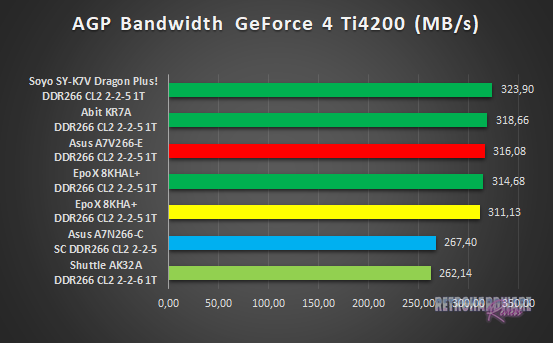
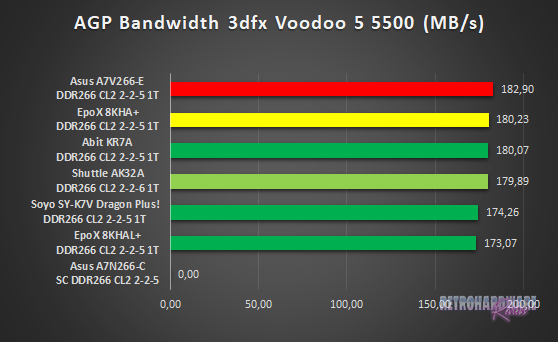
With the GeForce 4 Ti in the slot, the results for the Shuttle board are the lowest in the testfield and significantly lower than those of all other KT266A based boards tested. The performance in combination with the Voodoo 5 5500, however, is in line with the faster boards.
AGP and PCI Performance: 3DMark 2000 and ATTO
3DMark 2000 as a whole is very focused on TnL and is by far not as interesting for retro-hardware comparisons as its predecessor. Its “High Polygon Count, 1 Light” test, however, is another good way to measure the AGP performance. In opposite to the Final Reality test, the general system performance is also somewhat of importance. The benchmark was executed with the Geforce 4 Ti installed.
To measure PCI performance, I installed a Windows 98SE compatible SATA controller with a Samsung PM871 128GB SSD connected into the system. For the bench, I chose 1024 to 4096 KB block size and picked the overall best values for the read and write throughput. This test will show, which maximum performance can be expected with fast storage options like SATA or SCSI and maybe gives a hint, if the chipset might be good for Voodoo 2 cards.
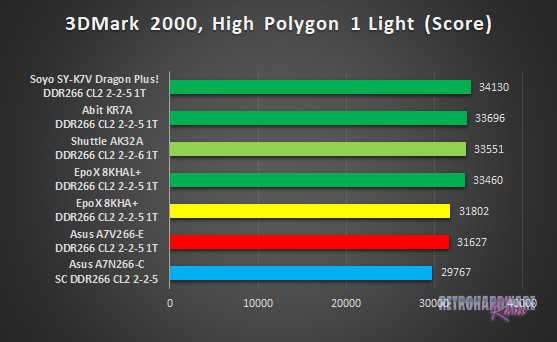
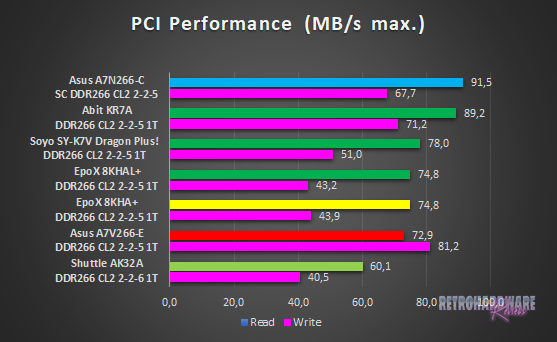
The AK32A ranks third in the 3DMark2000 sub-test, which is a very good result, given the low AGP bandwidth we saw in the test before.
The measured PCI throughput, however, is the lowest of the boards tested, for both read and write values.
Storage Performance: HDTach
To measure the performance of the board's IDE and (if available) onboard IDE RAID solutions' performance, I benched one of the latest and fastest IDE drives (the Hitachi Deskstar T7K500 500GB) with the HDTach benchmark. I also tried a much more “recent” drive (the Western Digital Blue Edition 500GB), which should be even faster in theory, but the Hitachi drive produced much better results in this test.
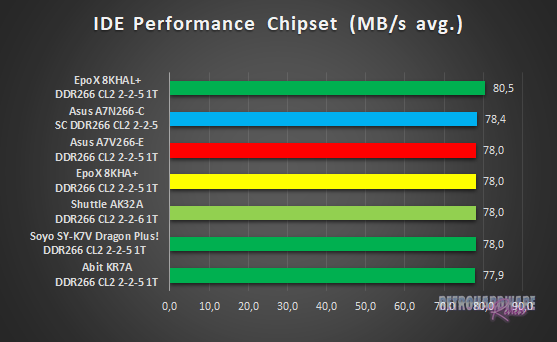
The IDE performance is in line with other KT266A based boards using the same VT8233 southbridge.
Gaming Benchmarks
Now that we got all the theoretical performance numbers, let's see how the contenders perform in 3D gaming benchmarks.
3D Performance: 3DMark99max
3DMark99max was released in early 1999 and comes without support for Hardware TnL. The maximum supported (hardware-) DirectX level is DX6. It is a great benchmark to reveal good overall system performance, as it rewards good memory bandwidth and latency more than the slight clockspeed advantage, that some boards have because of their factory-overclocked FSBs.
- Version: "latest"
- Settings: standard
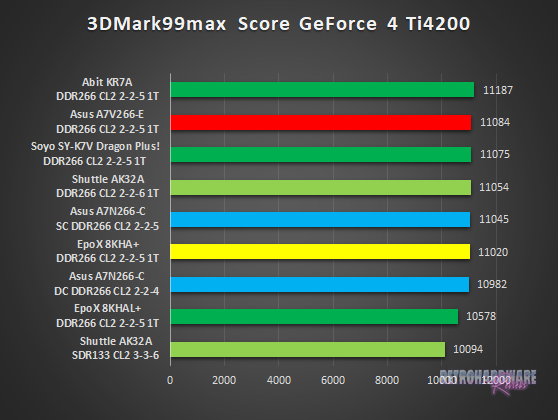
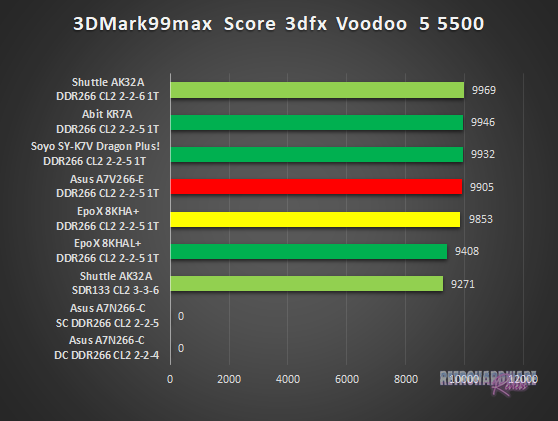
We see the AK32A showing a strong performance with both the GeForce 4 Ti and the Voodoo 5 installed. With the nVidia card, Shuttle's board is able to beat the nForce based A7N266-C as well as both EpoX boards with DDR memory installed. With the slower SDR memory, we see a performance hit of around 10%.
With the Voodoo 5, it even scores best of all the boards tested. The performance hit with SDR memory is not as big this time and while it achieves the lowest overall score using this type of memory, it is not far behind the EpoX 8KHAL+.
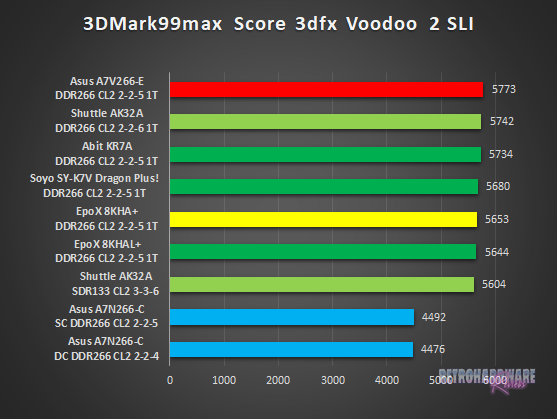
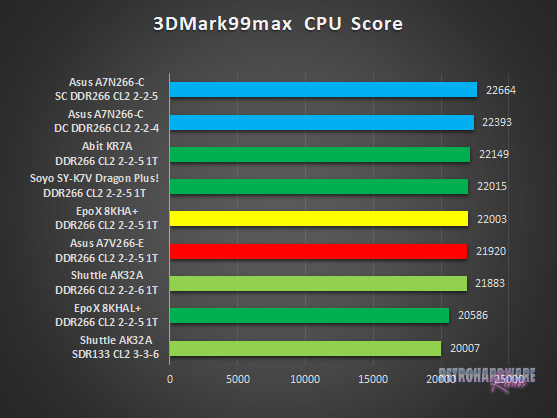
The low PCI performance we saw in the PCI bandwidth test seems not to affect the AK32A's performance with 3dfx Voodoo 2 cards, as it achieves second place with a pair of these cards in 3DMark99max. The performance hit with SDR memory is less than 3% this time.
In terms of CPU performance, the Shuttle board shows some of the lowest scores of the boards tested in 3DMark99max. Considering this and the low bandwidth results for both AGP and PCI we saw earlier, the very good overall 3DMark scores come a bit unexpected. Let's see how the board fares in actual gaming benchmarks.
3D Performance: Unreal Tournament (UT99) Timedemo(s)
Unreal Tournament (UT99) was released in November 1999 and is notorious for its hunger for CPU power. I chose to use two different timedemos for comparison, of which the utbench.dem timedemo is heavily CPU bound and therefore qualifies to measure the general performance of the boards. The second timedemo benchmark.dem is as GPU limited as possible in this game. This will reveal, how much impact a faster board can still have in more GPU limited situations. This game is also perfect to show, on which chipsets and boards Voodoo 2 cards run best.
- Version: 4.36
- Settings: High, Min desired Framerate "0", Show Decals [x], Use Dynamic Lightning [x]
- Geforce: D3D
- Voodoo 2 and Voodoo 5: Glide
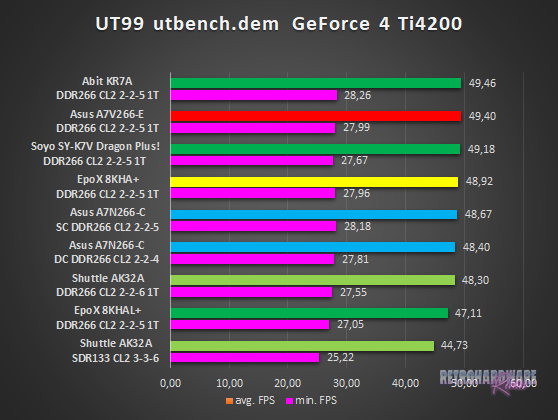
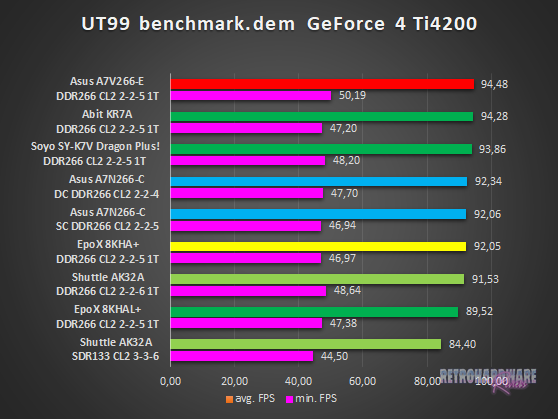
With the GeForce 4 Ti card installed, the AK32A lands at the bottom of the list, along with the EpoX 8KHAL+, which ranks between the AK32A's results with DDR and SDR memory. In the CPU limited utbench timedemo, the board performs roughly 10% worse with SDR memory than with DDR memory, comparable to what we saw with 3DMark99max results for the GeForce 4 Ti.
In the more GPU limited benchmark.dem timedemo, the difference is smaller. One thing I would like to mention is the very good result for the minimum FPS in this timedemo, which is the second best value of all the boards tested.
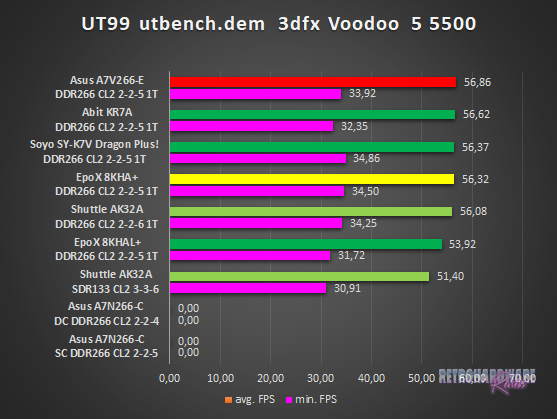
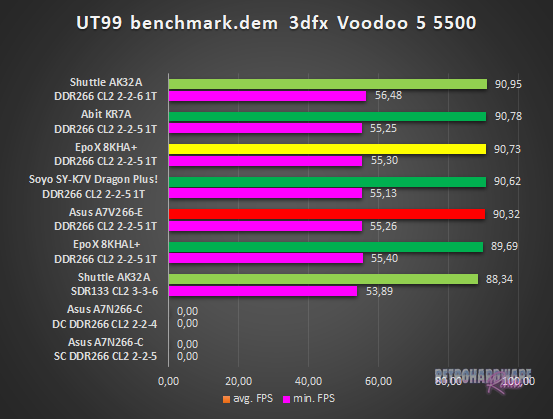
Things look quite a bit better with the 3dfx Voodoo 5 5500 in the system. While the position of the AK32A in the list remains unchanged in the utbench timedemo, it is less than 1 FPS behind the A7V266-E, which ranks first in this test. The minimum FPS with DDR memory are very good again and even better than those of the aforementioned Asus board.
In the benchmark.dem timedemo, it even comes in close first, with the highest values for both average and minimum FPS. The performance with SDR memory is surprisingly good and very close to all the other boards with DDR memory.
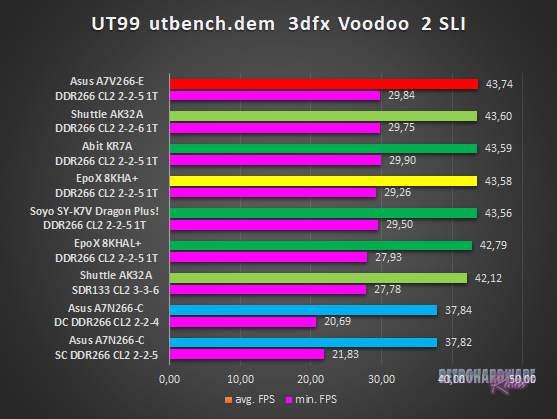
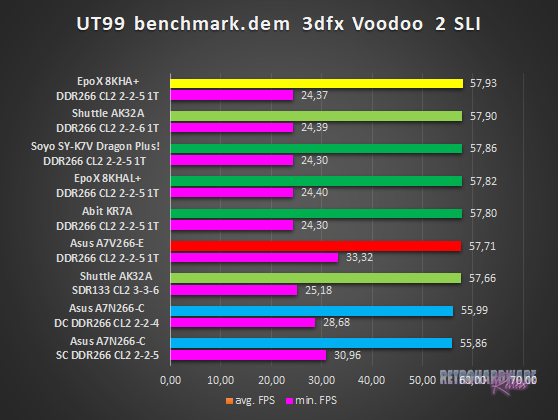
All (DDR-equipped) KT266A based boards, with the exception of the EpoX 8KHAL+, perform next to identical in the utbench timedemo. This is also true for the Shuttle AK32A, which takes second place using DDR memory. With SDR memory installed, its performance is still not much worse than that of the EpoX 8KHAL+ and significantly better than that of the nForce based Asus A7N266-C, which seems to have some problems with the Voodoo 2 cards in CPU limited situations.
The benchmark.dem timedemo is even more equalized in the average FPS results; the AK32A's performance with SDR memory installed is virtually identical to the board's performance with DDR memory. The minimum FPS with SDR memory installed are even better, which is a bit odd, since all the min FPS results for KT266A based boards with DDR memory installed (the A7V266-E excluded) are as close as it gets in such a test, and I don't see a reason why the board should perform better with SDR memory installed. But here we are.
3D Performance: Quake III Arena Timedemo
Quake 3 Arena was released shortly after Unreal Tournament, in December of 1999. It is known to reward fast memory latency and with its normal preset, it is completely CPU limited; at least for the GeForce 4 and the Voodoo 5. The Voodoo 2 SLI cards clearly limit the Athlon 1200 here, as the timedemo will show.
- Version: 1.32
- Settings: “Normal” Preset, only resolution changed to 1024x768x16
- Geforce 5 and Voodoo5: OpenGL
- Voodoo 2: “Voodoo” Renderer (miniGL)
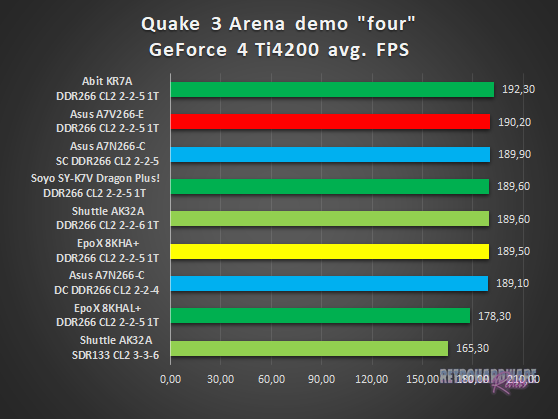
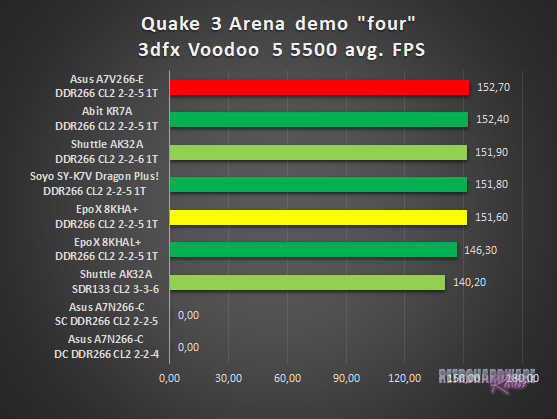
The AK32A performs well in Quake III Arena, with results close to those of the fastest boards in the test. With the GeForce 4 Ti installed, we see the largest performance drop (about 13%) in the board's SDR RAM results of any gaming benchmark in this review.
The performance penalty is much less with the Voodoo 5, the AK32A's performance with SDR memory is even relatively close to that of the EpoX 8KHAL+ here.
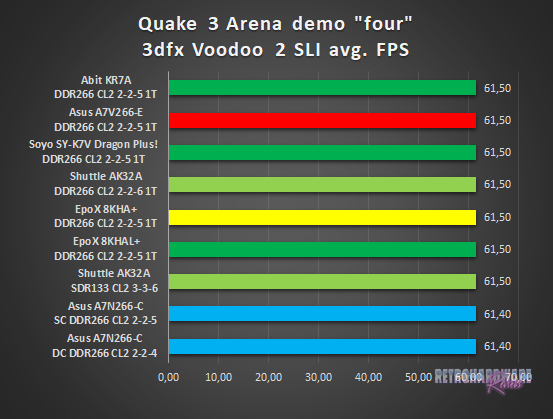
The Voodoo 2 SLI setup clearly limits here. All KT266A based boards score the same FPS, the nForce board is also just 0,1 FPS behind.
Summary & Rating
Shuttle AK32A (VIA KT266A)
-
Layout
-
Features
-
Overclocking Options
-
Compatibility
-
Documentation & Support
-
Performance: GeForce 4 Ti 4200
-
Performance: Voodoo 5 5500
-
Performance: Voodoo 2 SLI
OVERALL
| Pros | Cons |
| + Great layout | – Capacitors above CPU vs. big coolers |
| + Great performance | – Poor PCI performance |
| + Great CPU support | – Poor overclocking and tweaking options |
| + One of the fastest Socket A boards with SDR | |
| + Awesome “retro” support section on old Shuttle site |






Pingback: Review: Shuttle AK32 - www.retrohardware-reviews.de